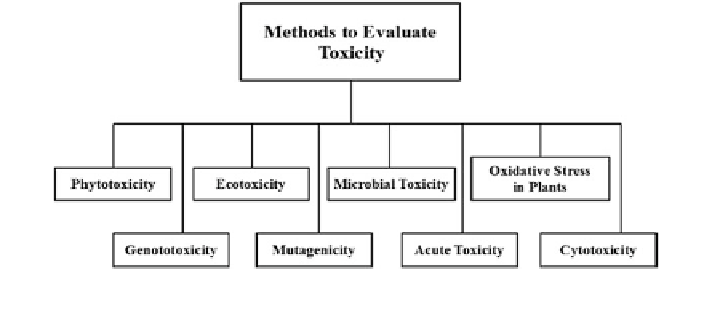Environmental Engineering Reference
In-Depth Information
Fig. 8
Methods to evaluate the toxicity of azo dyes and their degradation products present in
treated efuents (Solis et al.
2012
)
occupational sensitivity to azo dyes has been shown in textile industries since 1930
(Foussereau et al.
1982
). In addition, some azo dyes have been linked to bladder
cancer in humans, to splenic sarcoma, hepatocarcinomas and nuclear anomalies in
experimental animals and to cause chromosomal aberration in mammalian cells
(Mendevedev et al.
1988
; Percy et al.
1989
).
It is very important for any bioremediation technology to assess the toxicity of
the pollutants and metabolites formed after dye degradation in order to study the
feasibility of the method (Jadhav et al.
2011
). Toxicity of dyes and their metabolites
is evaluated by using various methodologies as indicated in Fig.
8
.
On the other hand, some studies have reported the metabolic pathway of azo dye
degradation by white-rot fungi (Martins et al.
2003
; Zhao et al.
2006
; Zhao and
Hardin
2007
; Lu et al.
2008
). These studies are very interesting, since they could
predict the expected by-products from azo dye biodegradation based on their
structure which would allow selecting the best strategy for the treatment of these
recalcitrant dyes.
6 Future Prospectives
Treatment of dye-containing ef
uents is a challenging task. Despite the research
efforts performed in the last decades, there is no single and economically attractive
method to decolourise and detoxify wastewater polluted with azo dyes. Therefore,
the need of an effective and environmentally friendly treatment at affordable cost is
today of utmost importance.
To apply biodegradation for the treatment of dye-containing wastewater, fungal
strains, capable of growing in a wide range of pH and temperature conditions and
capable of resisting the toxicity of the dyes even at higher concentrations, should be
chosen. Further, toxicity studies must be done to ensure the safety of the decol-
ourised wastewater. In this regard, a few studies have been conducted on testing the

Search WWH ::

Custom Search